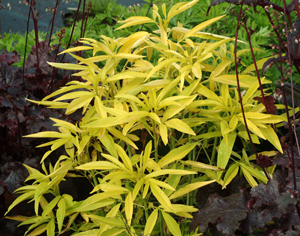We often hear about right plant right place when selecting and planting trees and shrubs. The phrase reminds us to take into account the mature size of a plant and how it will fit in the space we have along with its horticultural needs, such as sun or shade. The phrase applies to perennials and annuals, too.
About three years ago, Terra Nova Nurseries sent me ‘Lightning Flash,’ a tall coreopsis (C. tripteris) with chartreuse foliage, to try. The tag said it would get 3- to 5-feet tall, so I thought it would mix well with a batch of other coreopsis in the front yard, hoping it stay on the short end.
This is the first summer this perennial has bloomed and it is every bit of 5-feet tall, making it woefully out of place in its current location.

'Lightning Flash' coreopsis' foliage was supposed to be chartreuse, but it reverted to the green of the native species. Photo courtesy Terra Nova Nurseries
Lastly, the chartreuse foliage reverted to the green leaves of the native species. This reversion accounts for its height, too. So, this fall, I will move it to the back yard with other tall beauties.
Sometimes a plant is in the wrong place because of how it grows. Plants that spread by underground rhizomes, such as bishop’s weed or goat weed (Aegopodium podgraria) and gooseneck loosestrife (Lysimachia clethroides), can quickly take over a garden bed and overwhelm their neighbors.
A plant can be in the wrong place if it is getting too much or not enough sun. Most hostas do not thrive in full sun, especially those with blue or dark green leaves, which are better left for the shade. Most roses, however, are more likely to struggle in shady locations, because they need about six hours of direct sun a day to reach their potential.
This is a good time of year to make these evaluations in our landscape. September provides the perfect climate for transplanting perennials. A little later when the leaves have dropped and shrubs and trees have gone dormant, they can be transplanted.
No need to fertilize transplants this time of year. Make sure to water them deeply and regularly through fall until the ground freezes if we don’t get any rain.
